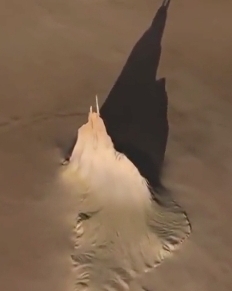  Io is the innermost of the four large moons of Jupiter discovered in 1610 by Galileo Galilei. Slightly larger than Earth’s moon, Io is the fourth-largest moon in the Solar System, and has the highest density and the strongest surface gravity of any moon.
Io is the innermost of the four large moons of Jupiter discovered in 1610 by Galileo Galilei. Slightly larger than Earth’s moon, Io is the fourth-largest moon in the Solar System, and has the highest density and the strongest surface gravity of any moon. With over four hundred active volcanoes, Io is the most geologically active object in the Solar System. This is the result of tidal heating from friction generated within Io's interior as it is pulled between Jupiter and the other Galilean moons Europa, Ganymede and Callisto. Some of its volcanoes produce plumes of sulfur and sulfur dioxide as high as 500 km above the surface, which is also home to more than one hundred mountains. Some of these peaks are taller than Mount Everest. Io is primarily composed of silicate rock surrounding a molten iron and iron sulfide core. Most of Io's surface is composed of plains with a frigid coating of sulfur and sulfur dioxide. Io's sulfurous volcanic lava flows decorate the surface in various shades of yellow, red, white, black, and green. Volcanic outgassing makes up Io's thin atmosphere. Volcanic ejections also create a large plasma ring around Jupiter. Galileo's discovery of the four large satellites of Jupiter helped to further the acceptance of the Copernican model of the Solar System, the development of Kepler's laws of motion, and the first measurement of the speed of light. In 1979, the two Voyager spacecraft revealed Io to be a geologically active world, with numerous volcanic features, large mountains, and a young surface with no obvious impact craters. The Galileo spacecraft performed several close flybys in the 1990s and early 2000s, obtaining data about Io's interior structure and surface composition. Further observations have been made by Cassini–Huygens in 2000, New Horizons in 2007, and Juno since 2017, as well as from Earth-based telescopes and the Hubble Space Telescope. The space agency's Juno spacecraft, which has orbited the gas giant Jupiter for nine years, passed within just 22,000 kilometres of Io (one tenth the distance from Earth to our moon), and took some of the most detailed views of Io ever captured, one of which is shown here.  Close flybys of Io, one of Jupiter’s moons and the most volcanically active world in our solar system, have also revealed a lava lake and a towering feature called 'Steeple Mountain' on Io's surface. Juno recently flew within 1,500 kilometers of the lava world’s surface in February 2024 to capture the first detailed images of Io’s northern latitudes.
Close flybys of Io, one of Jupiter’s moons and the most volcanically active world in our solar system, have also revealed a lava lake and a towering feature called 'Steeple Mountain' on Io's surface. Juno recently flew within 1,500 kilometers of the lava world’s surface in February 2024 to capture the first detailed images of Io’s northern latitudes.Other than the Earth, it’s the only place that we see active magma volcanoes going on in our solar system. Juno detected the mountain with the help of the sun shining on Io’s surface, which created dramatic shadows that revealed a very sharp peak, as shown in the recreation on the right. Although the temperature of the magma on Io amounts to thousands of degrees, the surface of the moon is likely minus 100 degrees Celsius. |